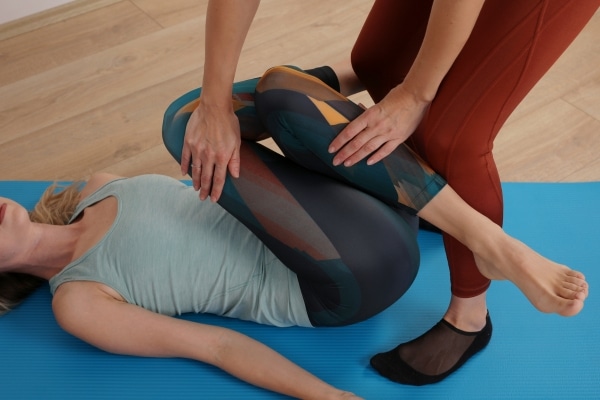Lower back pain is a pervasive ailment affecting individuals across various walks of life, casting a shadow over daily routines and professional endeavors. The quest for relief leads many down a path of temporary solutions that fail to address the root of discomfort. Amidst many treatment options, stretching emerges as a beacon of hope, offering a simple yet effective strategy to mitigate lower back pain. This article delves into the realm of easy stretches that promise to ease the discomfort, enhancing flexibility and strength in the lower back. As we navigate these gentle exercises, the emphasis remains on achieving pain relief without requiring invasive procedures, highlighting stretching’s pivotal role in maintaining back health and overall well-being.
Contents
Understanding Lower Back Pain

Lower back pain is a common affliction that often stems from various sources, including muscle strain, spinal abnormalities, or degenerative conditions. The complexity of the spine, coupled with the demands of modern lifestyles, exacerbates the risk of developing such discomfort. Prolonged periods of sitting, inadequate physical activity, and improper posture are just a few contributing factors. Recognizing these causes is paramount in adopting preventative and remedial measures to alleviate pain.
In addressing lower back pain, it’s crucial to discern the symptoms signaling its onset. Common indicators include discomfort while sitting, sharp pains during physical activity, or persistent aches. Early recognition and response can significantly curb the severity of the pain, preventing its escalation into more debilitating conditions. Awareness of these symptoms not only aids in timely intervention but also educates individuals on when to seek professional medical advice, ensuring that the pain is managed effectively and safely.
Importance of Stretching for Back Health

Often overlooked in exercise, stretching plays a vital role in combating lower back pain. Regular stretching exercises enhance flexibility, promote blood flow, and strengthen the muscles surrounding the spine. These benefits collectively reduce existing pain and act as a preventive measure against future discomfort. By incorporating stretching into one’s daily routine, individuals can maintain a healthier back, significantly improving their quality of life.
Moreover, health professionals widely advocate including stretching in managing lower back pain. Through gentle, consistent stretching, individuals can achieve improved posture and mobility, significantly reducing the strain on the lower back. This practice, endorsed by physiotherapists and healthcare providers, underscores the importance of stretching as a therapeutic activity and a cornerstone of back health maintenance.
Warm-Up Stretches

Before delving into stretches specifically alleviating lower back pain, emphasizing the importance of warming up cannot be overstated. A proper warm-up prepares the body for the stretching routine, enhancing the flexibility of muscles and reducing the risk of injury. Simple activities like a brisk walk or gentle jogging for a few minutes can significantly increase blood flow to the muscles, making them more pliable and responsive to stretching. This preliminary step is crucial for a safe and effective stretching session, especially when targeting the sensitive areas of the lower back.
Introducing specific warm-up stretches that target the lower back area is equally important. Exercises such as pelvic tilts and the cat-cow stretch warm the body and address the stiffness and discomfort in the lower back directly. These stretches engage the core muscles and the spinal column, promoting mobility and preparing the body for more intensive stretching. By carefully performing these warm-up exercises, individuals can ensure a smoother transition into their stretching routine, optimizing the benefits for their lower back.
Core Strengthening Stretches

The core muscles play a pivotal role in supporting the lower back, and their strength directly impacts the health and comfort of the spine. Strengthening these muscles through targeted stretches can alleviate pressure on the lower back by providing better support. Exercises such as planks and bridges are highly effective in engaging and strengthening the core, including the abdominal muscles, back muscles, and the muscles around the pelvis. By incorporating these stretches into a routine, individuals can build a stronger foundation, reducing the likelihood of lower back pain.
In addition to the benefits of core strength on back health, these stretches offer the advantage of being performable almost anywhere without requiring specialized equipment. Clear instructions for executing these stretches safely can ensure maximal benefit and minimize the risk of injury. For instance, maintaining proper form during a plank involves keeping the body straight from head to heels, enhancing the stretch’s effectiveness. Regularly practicing these core strengthening stretches can significantly improve lower back health and overall physical wellness.
Targeted Lower Back Stretches

Focusing on stretches targeting the lower back can directly address the discomfort and stiffness many experience. The knee-to-chest stretch is a prime example of an exercise that focuses on relaxing and stretching the muscles in the lower back. By gently pulling one knee at a time to the chest, individuals can feel a soothing stretch in their lower back, providing immediate relief from tension and pain. Such targeted stretches are essential in any routine to ease lower back pain, offering a direct method to alleviate discomfort.
Moreover, providing detailed instructions for each stretch, including the recommended duration and frequency, empowers individuals to practice these exercises safely and effectively. Emphasizing the importance of listening to one’s body during these stretches ensures that the exercises provide relief without causing further strain. Regularly incorporating targeted lower back stretches into one’s routine can lead to long-term benefits, including reduced pain, increased flexibility, and improved posture.
Flexibility and Mobility Stretches

Improving overall flexibility and mobility is crucial in managing lower back pain. Stretches that extend beyond the lower back, targeting areas such as the hips and hamstrings, can indirectly relieve back pain by reducing tension in interconnected muscle groups. For instance, tight hamstrings can increase the strain on the lower back, exacerbating pain. Therefore, incorporating stretches like the hamstring or the piriformis stretch into one’s routine can provide comprehensive benefits, enhancing mobility and reducing the risk of further lower back issues.
Advising on integrating these flexibility and mobility stretches into daily activities can encourage a more proactive approach to managing lower back pain. Whether through dedicated stretching sessions or incorporating stretches into breaks throughout the day, individuals can find ways to make stretching a consistent part of their lives. This commitment to flexibility and mobility not only
aids in alleviating current discomfort but also serves as a preventive measure against future lower back pain. By fostering an environment where stretching becomes a daily habit, individuals can enjoy a more active, pain-free life.
Incorporating Stretches into Your Routine

Creating a sustainable routine with stretches for lower back health requires a strategic approach. It’s about integrating these exercises into daily life in a natural and manageable way. Recommendations for building a stretching routine might include setting specific times of the day for stretching, such as after waking up or before bed. These practices ensure that stretching becomes a regular part of one’s day, contributing to the overall health of the lower back without feeling like a burdensome addition to one’s schedule.
The challenge often lies in maintaining motivation and consistency. Setting realistic goals, tracking progress, and involving a friend or family member in the routine provide the encouragement needed to stick with it. Celebrating milestones, no matter how small can also reinforce the habit. Understanding that flexibility and back health improve gradually and recognizing the signs of progress can keep individuals motivated. These steps not only enhance the effectiveness of the stretching routine but also integrate it as a valuable component of a healthy lifestyle.
When to Seek Professional Help

Recognizing when stretching alone is insufficient and professional medical advice is necessary is critical in managing lower back pain effectively. Specific symptoms, such as persistent pain that doesn’t improve with stretching, pain that radiates down the legs, or discomfort accompanied by other worrying signs like weight loss or fever, require immediate attention from a healthcare provider. These signs could indicate underlying conditions that simple stretches cannot address, underscoring the importance of professional evaluation and treatment.
Incorporating advice from healthcare professionals into a stretching routine can optimize its effectiveness and ensure safety. Physical therapists, for example, can offer personalized stretching programs tailored to individual needs and conditions, enhancing the relief from lower back pain. They can also guide you on how to perform stretches correctly, avoiding further injury. Seeking and following professional advice augments the benefits of a stretching routine and ensures that individuals receive comprehensive care for their lower back pain.
Final Thoughts
Easing lower back pain through simple stretches offers a noninvasive, accessible solution for countless individuals grappling with this joint discomfort. This article has explored the significance of understanding lower back pain, the profound benefits of stretching for back health, and detailed instructions for incorporating effective stretches into daily routines. Embracing these practices can significantly improve flexibility, strength, and overall well-being, reducing the impact of lower back pain on one’s life.